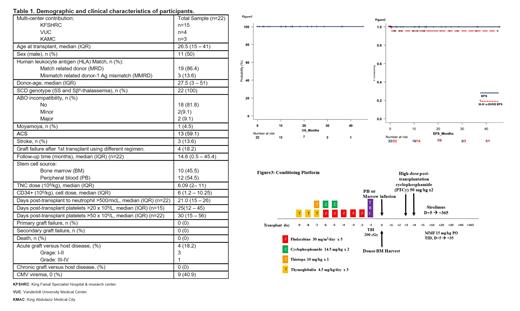Introduction:
The validated curative treatment for sickle cell disease (SCD) is allogeneic hematopoietic stem-cell transplantation (HSCT). Despite paucity of available matched sibling donors (10-14%), they are preferred due to less immunogenic complications like graft versus host disease (GVHD) and graft failure (GF) using alternative donors. In-vivo T-cell depletion by post-transplant cyclophosphamide (PTCy) has been shown to be most effective in GVHD control and a non-myeloablative regimen minimizes the toxicity associated with HSCT in this vulnerable population.
In 2013, the multi-institutional Vanderbilt Haploidentical Learning Collaborative showed the improved outcomes of their non-myeloablative regimen for related haploidentical BMT for SCD (ClinicalTrials.gov identifier NCT01850108). We used a similar non-myeloablative approach to improve donor engraftment rates, while minimizing GVHD.
Material and methods:
This study was conducted at three international centers using similar conditioning from our experience in multi-institutional Vanderbilt Global Haploidentical Learning Collaborative to optimize haploBMT for SCD. The conditioning regimen included ( Figure3): rabbit anti-thymoglobulin (ATG) 4.5 mg/kg, thiotepa 10 mg/kg, fludarabine 150 mg/m2, cyclophosphamide 29 mg/kg and total body irradiation (TBI) 200 cGy. GVHD prophylaxis included PTCy 100 mg/kg, mycophenolate mofetil (MMF), and sirolimus. Stem cell source included bone marrow (BM) mobilized with filgrastim (5-10 μg/kg/d x 3-5 days) and peripheral blood (PB). Primary graft failure (GF) was defined as <5% donor myeloid/lymphoid chimerism or <5% donor cells by whole blood (WB) chimerism by day+28 posttransplant. Secondary graft rejection was defined <5% donor myeloid/lymphoid chimerism or <5% donor cells by whole blood (WB) chimerism with prior documentation of >5% donor cells by day +28. The Event free survival (EFS) was defined by survival with no GF, no death and/or no chronic GVHD. This cohort includes 4/22 patients (18.2%) had prior graft failure from a previous bone marrow transplants.
Results:
Here we report the outcome of 22 SCD patients (100% HbSS genotype), with a median age of 26.5 (15-41), transplanted from 10/10 MRD 86.4 % (n= 19) or single antigen mismatch related donor (MMRD) (9/10) 13.6% (n=3). The stem cell source was PB in 54.5% (12/22), and BM in 45.5% (10/22). Median CD34 stem cells dose was 6 X 10 6/Kg (1.2 - 10.25). Neutrophils and platelets engrafted at a median of 21.0 (15 - 26) and 25.0 (12 - 45) days, respectively. Demographic and clinical characteristics of participants summarized in Table 1. No primary or secondary graft failure was observed in the participants based on the last follow-up and time of analysis of this report. For participants with durable engraftment, the median WB chimerism values for D+28 and D+365 engraftment was 99.25% (n=14; IQR: 52 - 100) and 96.5% (n=16; IQR: 52 - 100), respectively. The median follow-up time was 14.6 months (n=22; IQR: 0.5-45.44). The overall incidence of acute GVHD grade III-IV was 4.5% (n= 1/22), and no incidence of chronic GVHD. There was no transplant related mortality. A Kaplan-Meier based probability of overall survival (OS) was 100%, Figure 1. All patients were off immunosuppression at 1-year post transplant. EFS as defined in the method was 100%, Figure 2. The EFS of free acute GVHD grade III-IV was 95.5%.
Conclusion:
This result shows the superiority of Thiotepa based non-myeloablative conditioning and PTCy for MRD transplants in adults with severe SCD. It not only minimizes the toxicity and GVHD but provides optimal donor engraftment mitigating against risk of secondary myeloid neoplasms from mixed chimerism. This needs further validation in a larger cohort.
Disclosures
Alzahrani:Kite: Consultancy, Speakers Bureau.


This feature is available to Subscribers Only
Sign In or Create an Account Close Modal